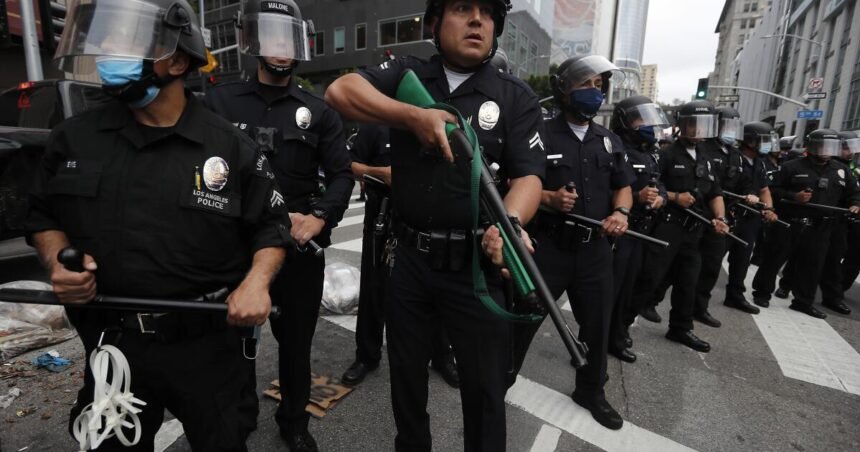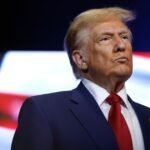As mass protests over the police murder of George Floyd raged across Los Angeles in late May 2020, the LAPD had an unexpected problem.
After a week of demonstrations, officers had fired so many “less-lethal” crowd control projectiles made of rubber that the department’s stockpile was running low.
Scrambling to buy more, officials arranged for two reserve officers to fly a private plane to Casper, Wyo., to pick up 2,000 additional rounds from an arms wholesaler called Safariland, according to LAPD emails reviewed by The Times.
The days and weeks that followed brought more unrest in the streets, with police criticized for indiscriminately firing rubber rounds into crowds, injuring scores of people with shots to the face or torso.
Multiple reports and activists assailed the department’s response to the protests as a botched operation that resulted from poor planning, inadequate training and failure to learn from past mistakes.
According to The Times’ analysis of LAPD data released by the L.A. city attorney’s office, police actions related to the George Floyd protests have cost $11.9 million in settlements and jury awards. Scores of other pending lawsuits represent potentially tens of millions more in liability exposure.
Yet five years removed from Floyd’s killing, police backers say public opinion has largely swung back in favor of aggressive law enforcement, pointing as proof to last year’s passage of tough-on-crime legislation and ousting of progressive prosecutors.
Last month, President Trump issued an executive order promising to “unleash high-impact local police forces” in his administration’s campaign against “criminal aliens.”
The U.S. Department of Justice moved last week to cancel settlements to overhaul police departments in Louisville, Ky., and Minneapolis. The federal oversight was part of the national reckoning with racism and police brutality that followed the law enforcement killings of Breonna Taylor and Floyd, who was pinned to the pavement by a police officer for nearly 10 minutes before dying.
The push to overhaul the LAPD that began in 2020 did not result in sweeping changes, but the Police Department has in some ways come to resemble the slimmed-down version sought by some activists.
While its multibillion-dollar budget has only grown, the number of low-level arrests and traffic stops have plummeted, and staffing shortages have forced the department to focus more on responding to and solving violent crimes.
Today, the department is nearly 1,300 officers smaller than it was when Floyd died, with fewer cops on the force than at any point since 1995, mirroring nationwide declines in police staffing.
On Thursday, the L.A. City Council signed off on a $14-billion spending plan for 2025-26 that cuts funding for police recruitment in order to avoid laying off hundreds of city workers. The council provided enough money for the LAPD to hire 240 new officers over the coming year, down from the 480 proposed by Mayor Karen Bass last month.
Asked in a news radio appearance last week whether Floyd’s death had changed policing, LAPD Chief Jim McDonnell said it had, largely with the slump in hiring.
LAPD Chief Jim McDonnell, center, and Capt. James Hwang perform the uniform inspection during graduation for recruit class 11-24 on May 2.
(Myung J. Chun / Los Angeles Times)
The department lost scores of cops who didn’t “feel support,” he said, and recruitment continues to prove challenging.
“So that has had a negative impact on the profession overall,” he told public radio station KCRW. “We have to restore morale within the organization; we have to restore pride within the profession.”
Following years of calls for embracing alternatives to traditional policing, LAPD officials and city leaders are continuing to explore ways to hand off calls involving substance abuse, homelessness and mental illness. Officers are also no longer responding to minor traffic accidents.
Efforts to limit police traffic involvement have gained some traction, and a controversial policy enacted by former Chief Michel Moore still restricts so-called pretextual stops of motorists or pedestrians that critics say led to the disproportionate harassment of Black and brown Angelenos. The department has also taken steps to try to limit dangerous pursuits by asking supervisors to monitor them in real-time, and if the chase proves too dangerous, to call them off.
Police data show violent crime continues to drop from pandemic highs, with the exception of aggravated assaults and robberies in certain parts of the city. Property crimes, including most burglaries, have also started to trend downward.
Some efforts at reform have stalled, including a proposal to overhaul the department’s disciplinary system for officers. Another plan that would have replaced LAPD officers with unarmed transportation workers on traffic stops sputtered amid debates around jurisdiction and funding.
Art Acevedo, who began his career with the California Highway Patrol before serving as police chief in several major cities including Houston and Miami, blamed movements to “defund” and “abolish” police for polarizing the debate on how to move forward.
Acevedo, who applied for the LAPD chief’s job that eventually went to McDonnell, said police unions and allies weaponized such rhetoric because it “effectively equated advocating for police reform as one and the same as advocating for defunding the police.”
“That movement created a backlash that has translated into a diminished appetite” for reform, he said.
Acevedo also worried about officers feeling emboldened to bend or break the rules in the current climate: “You don’t want to re-create the perception, real or not, that it’s open season for bad policing, because you’re going to have that small percentage that’re going to act on that belief that they’re not going to be held accountable.”
Melina Abdullah, co-founder of Black Lives Matter-Los Angeles, shared similar concerns.
“I think they absolutely feel unleashed,” she said of police. “Not that they were ever on a leash.”
Part of the problem, Abdullah said, is public fatigue over the seemingly constant barrage of troubling incidents.
“People don’t have the bandwidth to respond with the kind of outrage that they would when you saw the beatings at Pan Pacific Park,” said Abdullah, referring to the LAPD’s response to protests in 2020.
John Burton, an attorney who filed lawsuits on behalf of several people who were wounded by less-lethal rounds during L.A. protests in 2020, said that most changes to the LAPD have been around the edges, but the department hasn’t addressed its culture of aggression.
The lack of progress, he said, is obvious in the LAPD internal affairs investigations he’s reviewed that rarely found anything wrong with officers’ use of force — even in the face of overwhelming video evidence. More than a few officers mentioned in his lawsuits have since been promoted, he said, even after he accused them of lying in police reports.
LAPD supervisors looked the other way, he said, because they are “very protective” of their officers.
Burton also noted that rubber projectiles are still being used, despite little evidence the weapons helped rein in chaos on the streets. Police also once faced criticism last year for the handling of pro-Palestinian protests on the USC and UCLA campuses.
“The thought that you’re going to stop somebody from throwing a rock at the cops by shooting one of these first is a fantasy,” he said. “They can cause very serious injuries.”
The Associated Press contributed to this report.







